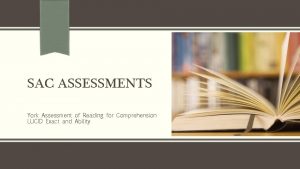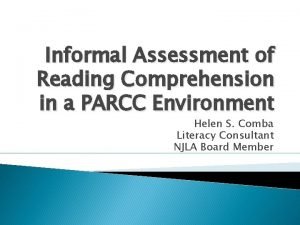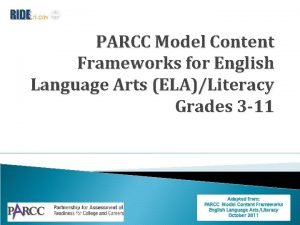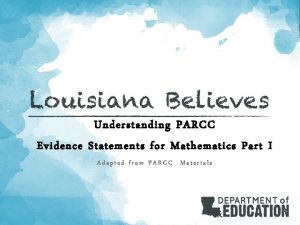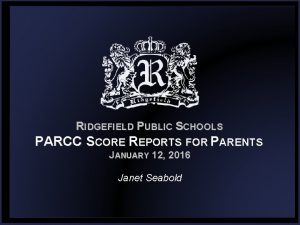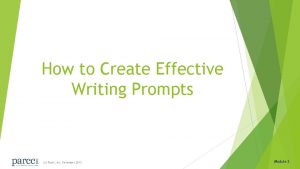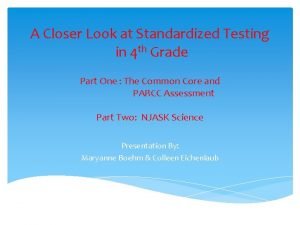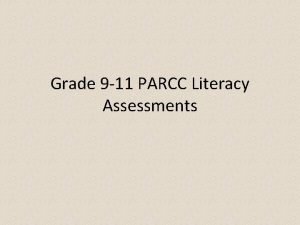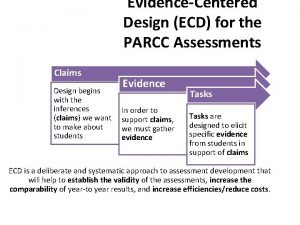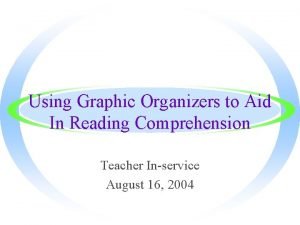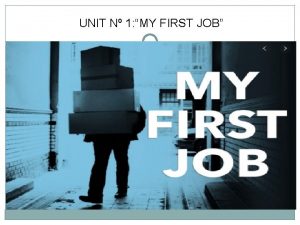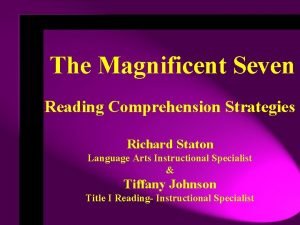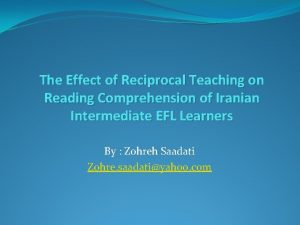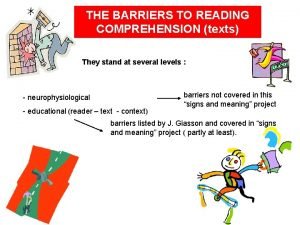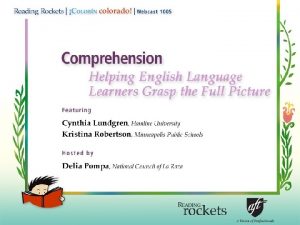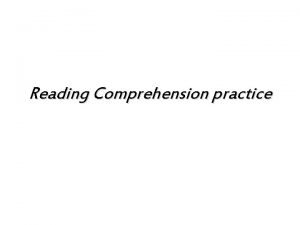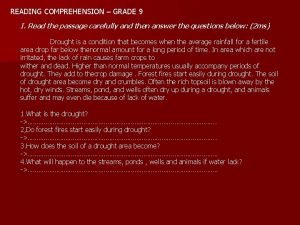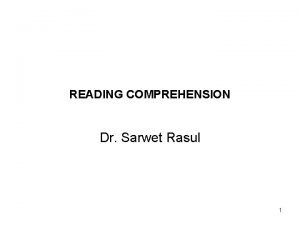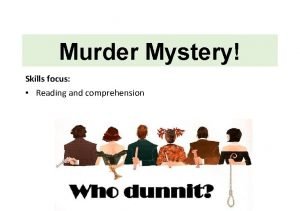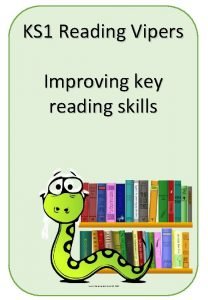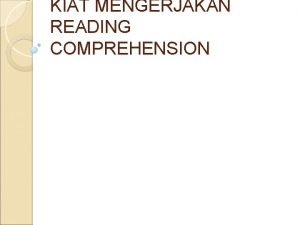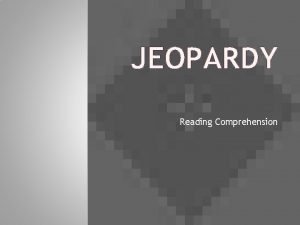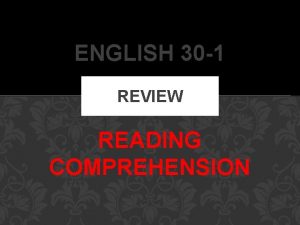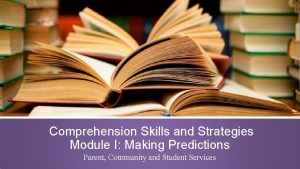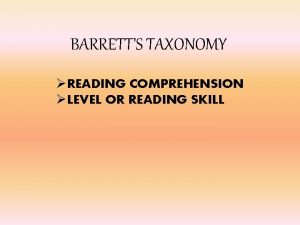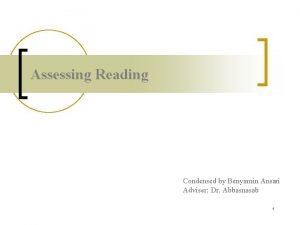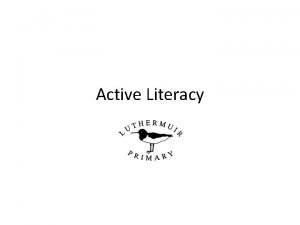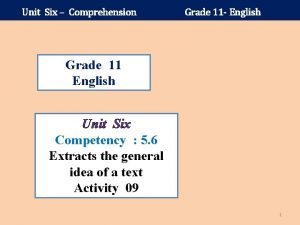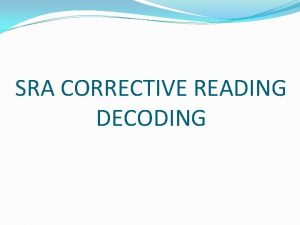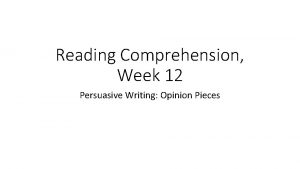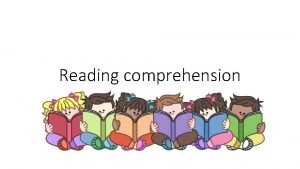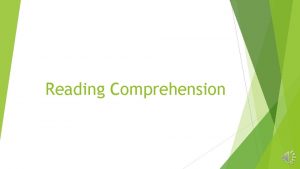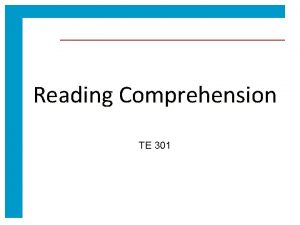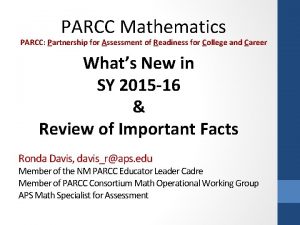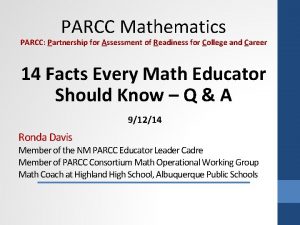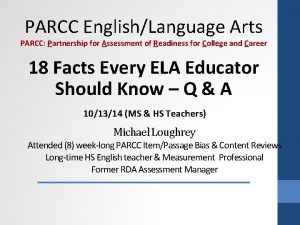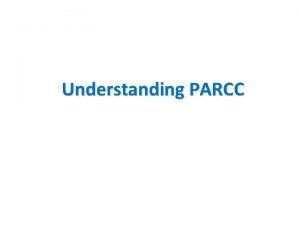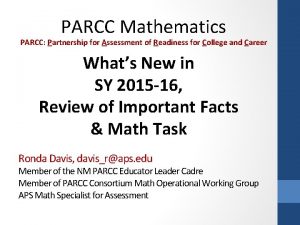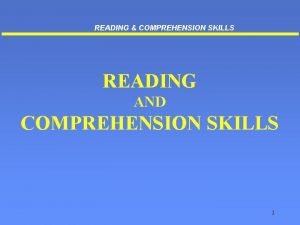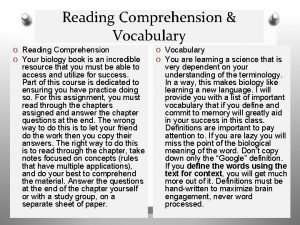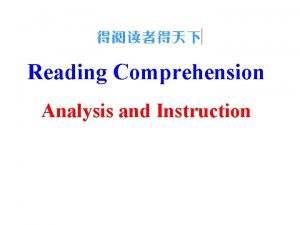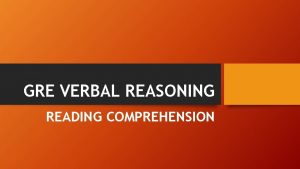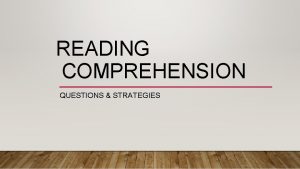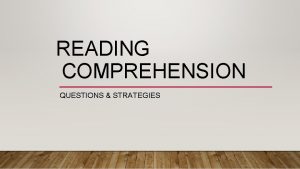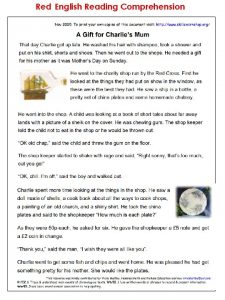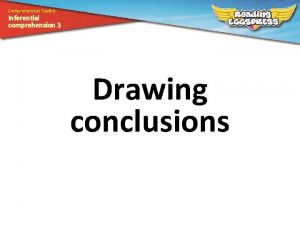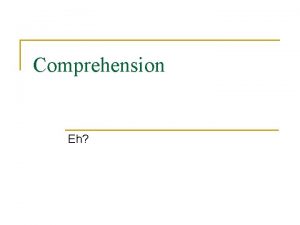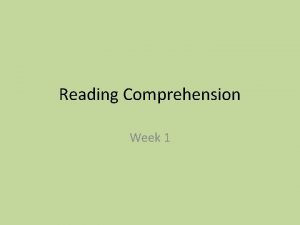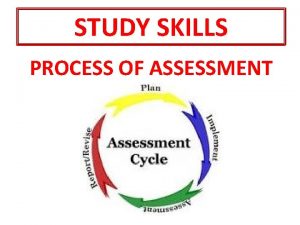Informal Assessment of Reading Comprehension in a PARCC







































- Slides: 39

Informal Assessment of Reading Comprehension in a PARCC Environment Helen S. Comba Literacy Consultant NJLA Board Member

This workshop will provide: The purpose of this workshop is to provide teachers with an informal assessment framework and resources that will lead to a deeper understanding of the strategies that students use to comprehend text and how written language can further our understanding of what our students are thinking. q An overview of assessment q A framework for informal assessment q Instructional strategies linked to informal assessment

A Marsden Giberter � � Glis was very fraper. She had dernarpen Farfle’s marsden. She did not talp a giberter for him. So, she conlanted to plimp a marsden binky for him. She had just sparved the binky when he jibbed in the gorger. “Clorsty marsden!” she boffed. “That ‘s a crouistish marsden binky, ” boffed Farfle, “but my marsden is on Stansan. Agsan is Kelsan. ” “In that ruspen, ” boffed Glis, “I won’t wank your giberter until Stansan. ” 1) Why was Glis fraper? 2) What did Glis plimp? 3) Who jibbed the gorger when Glis sparved the blinky? 4) Why didn’t Glis wank Farfle his giberter?

Did you? ? ? How would I know? � Read closely to determine what the text said? � Make logical inferences? � Determine the central idea or theme of the text? � Interpret words or phrases as used in the text? � Analyze the structure of the text including specific sentences and passages? � Assess purpose or point of view of the text?

Assessment includes Summative Diagnostic Formative

Summative Assessment � Evaluative � Tests � Performance Tasks � Culminating Projects � Portfolios

Diagnostic Assessments � Precede instruction � Prior knowledge check � Assesses Skill Level � Interest Inventories � Learning- style preferences � Reveal misconceptions

Formative Assessments � Provide specific feedback � Guide teaching to improve learning � Quizzes � Oral Questioning � Think alouds � Student-constructed graphics � Portfolio reviews � Teacher observations � Draft work


Keeping these categories of assessment in mind, let’s consider specific assessment practices that can enhance teaching and learning.

Informal Assessment is the key. � Seamless with instruction. � Provides a process linking assessment to learning. � More “real world” or authentic than formal assessments. *http: //www. ascd. org/publications/e ducationalleadership/nov 05/vol 63/num 03/Sev en-Practices-for-Effective. Learning. aspx

Use Tools that Link Formative and Summative Assessment � Criteria � Rubrics � Student and models shown in advance Work � Feedback � Self-Assessment Questions

Practice 1: Use summative assessments to frame meaningful performance goals. UNPACK PARRC: Practice Test Grade 4 In those wacky shoes, a girl has to outsmart a pair of shoes. Think about the details the author uses to create the characters, settings and events. Imagine that you, like the girl in the story, find a pair of wacky shoes that won’t come off. Write a story about how you find a pair of wacky shoes and what happens to you when you wear them. Use what you have learned about the wacky shoes when you write the story.

Practice 2: Show Criteria & Models in Advance CCSS-ELA-Literacy. RL 4. 3: Describe in depth a character, setting, or event in a story or drama, drawing on specific details in the text (e. g. , a character’s thoughts, words, or actions. ) AS Grade 4 “I can” statement: I can describe characters in a story (their traits, motivations or feelings) and explain how their actions contribute to the sequence of events. http: //www. thecurriculumcorner. com/thecurriculumcorner 456/eve rything-i-can-common-core-for-4 th-grade/

Practice 3: Assess before teaching. How does this teacher authentically assess student work? � https: //www. teachingchannel. org/videos/daily-lessonassessment � What is the teacher doing? � What are the students doing? � How does the teacher use student work to inform instruction?

Practice 4: Offer appropriate choices. Interactive Read Aloud Strategies • Mentor Texts • Post-it Notes • 4 square sheet Purpose: • Students reveal their thinking across pages • Used for teaching inferencing • Used for summarizing text • Used for initial stages of essay development

http: //www. theteachertoolkit. com/index. php/tool/four-corners

Application: Four Corners Activity In the story, This Is Not My Hat, the little fish is mostly responsible for the outcome of the story. Do you agree? A. Do you strongly agree? B. Do you agree? C. Do you strongly disagree? D. Do you disagree?

Practice 5: Provide feedback early and often. • • • What kind of questions have been asked? Are they worthy questions? What other kinds of thinking has been revealed? Of your four Post-its. Which Post-it is the most worthy? Can it be used for writing long?

In the classroom: Looking at Student Work � Teacher uses conferencing with students throughout the entire process. � Teacher assesses student use � of reading strategies � Importance of written language to reveal thinking about text.

Teacher scaffolds instruction during conferencing leaving written notes for the student to use.

So what about feedback? � Provides feedback early and often � It must be timely, specific, understandable to the learner, and formed to allow for selfadjustment on the part of the learner (Wiggins, 1998). � Kid language rubrics can help to make feedback comprehensible. � The writing process cycle: drafting, feedback and revision

Formative Assessment Feedback

Summative Assessment Feedback

Practice 6: Encourage selfassessment and goal setting. � Rubrics can help students become more effective at selfappraisal and goal setting. � Rubric can include space for feedback. � Initially teacher models how to self-assess, set goals and plan improvements by asking questions. � Use I can statements with rubrics to facilitate selfassessment & goal setting.

Self-Assessment using a Rubric

Self-Assessment Questions � What aspect of my work was most effective? � What aspect of my work was least effective? � What specific actions will improve performance? � What will you do differently next time?

& Peer Assessment

Practice 7: Allow new evidence of achievement to replace old evidence.

Performance Tasks Put it All Together � Understanding by Design ® (2012, 2011, 2005), Grant Wiggins and Jay Mc. Tague proposed that the most effective teaching is planned “backward” from desired learning outcomes (e. g. , academic standards, 21 st century skills) and from the assessments that will show evidence of their attainment

PARCC: Research Tasks � Today you will research how zoos impact animals. You will read one article titled “The Stripes Will Survive. ” Then you will read one passage titled “The Zoos Go Wild” and view one video “Behind the Scenes with the National Zoo’s Lion Cubs’. As you review these sources, you will gather information and answer questions about how zoos impact animals so you can write an essay.

Show Criteria: Start with Standards and Goals CCSS. ELA-Literacy. RI. 6. 7 Integrate information presented in different media or formats as well as in words to develop a coherent understanding of a topic or issue. Grade 6 “I can” statement for reading: I can demonstrate understanding of a topic or issue using information from various media/formats.

Writing is integrated with reading. . . CCSS. ELA-LITERACY. W. 6. 7 Conduct short research projects to answer a question, drawing on several sources and refocusing the inquiry when appropriate. Grade 6 “I can” statement for writing: I can conduct short research projects to answer a question.

Informal Assessment by Design Using Text Sets: � Henry’s Freedom Box: A True Story from the Underground Railroad by Ellen. Levine https: //www. youtube. com/watch? v=VGW 0 Pwv. FZ 04 � Debate: Better Late Than Never by http: //www. readworks. org/books/sweet-clara-andfreedom-quilt Using evidence from Sweet Clara and the Freedom Quilt, Henry’s Freedom Box and the Debate: Better Late Than Never, write an editorial explaining whether or not it would make sense for states to apologize now for the slavery that happened in the past.

Creating a Cross-Curricular Model: GRASPS ● ● ● ● Goal Role Audiences Situation Products or Performances Standards http: //www. rememberit. org/Documents/GRASPS% 20 examples. pdf http: //www. rememberit. org/Documents/MPS%20 E LA%20 GRASPS. writing%20 grasps. pdf

The Apology Debate ● ● ● Goal: To write a letter to the editor of the newspaper where The Debate: Better Late Than Never article appeared. Role: A letter writer responding to the editor of the newspaper. Audiences: The editor of the newspaper as well as anyone who reads this newspaper. Situation: You either agree or disagree with the editor Products or Performances: A three paragraph letter including evidence based on readings that support your opinion. Anchor Standard: W 1 Write arguments to support claims in an analysis of text or topics.

Use Real World Type Scenarios ● ● https: //contemporaryissuesatrutgers. wikispaces. co m/file/view/Develop+Performance+Tasks. pdf http: //www. readworks. org/lessons/grade 4/sweetclara-and-freedom-quilt/paired-text-questions


Take. Away Three! 1. Use summative assessments to frame meaningful performance goals. 2. Show criteria and models in advance. 3. Assess before teaching. 4. Offer appropriate choices. 5. Provide feedback early and often. 6. Encourage self-assessment and goal setting. 7. Allow new evidence of achievement to replace old evidence.
 Yarc conversion tool
Yarc conversion tool Example of formative assessment
Example of formative assessment Strengths in reading
Strengths in reading Pre reading while reading and post reading activities
Pre reading while reading and post reading activities Parcc model content frameworks
Parcc model content frameworks Parcc evidence statements
Parcc evidence statements Parcc scoring guide
Parcc scoring guide Fatp writing strategy
Fatp writing strategy What does parcc stand for
What does parcc stand for Parcc
Parcc Parcc evidence statements
Parcc evidence statements Nature inspired inventions
Nature inspired inventions Story maps for reading comprehension
Story maps for reading comprehension My first job reading comprehension
My first job reading comprehension Unit 1 jobs
Unit 1 jobs 7 comprehension strategies
7 comprehension strategies Define reading comprehension
Define reading comprehension Comprehension barriers
Comprehension barriers Text comprehension meaning
Text comprehension meaning Birthday party reading comprehension
Birthday party reading comprehension I were you i would
I were you i would Comprehension grade 9
Comprehension grade 9 Rasul gamzatov ship
Rasul gamzatov ship Define reading comprehension
Define reading comprehension Super 6 reading strategies
Super 6 reading strategies Focus
Focus Viper skills reading
Viper skills reading Tersurat
Tersurat Main idea and details jeopardy
Main idea and details jeopardy Modern drama reading comprehension test
Modern drama reading comprehension test Reading comprehension making predictions
Reading comprehension making predictions Headsprout comprehension
Headsprout comprehension Barrett's taxonomy of comprehension skills
Barrett's taxonomy of comprehension skills Cloze reading examples
Cloze reading examples The reading pyramid
The reading pyramid How to answer comprehension questions grade 11
How to answer comprehension questions grade 11 Corrective reading decoding placement test
Corrective reading decoding placement test Persuasive writing comprehension
Persuasive writing comprehension Birthday party reading comprehension
Birthday party reading comprehension Advantages of scanning in reading
Advantages of scanning in reading
